This article was co-authored by wikiHow Staff. Our trained team of editors and researchers validate articles for accuracy and comprehensiveness. wikiHow's Content Management Team carefully monitors the work from our editorial staff to ensure that each article is backed by trusted research and meets our high quality standards.
wikiHow marks an article as reader-approved once it receives enough positive feedback. In this case, 100% of readers who voted found the article helpful, earning it our reader-approved status.
This article has been viewed 93,575 times.
Learn more...
An exegesis is an essay that focuses on a particular passage in the Bible. A good exegesis will use logic, critical thinking, and secondary sources to demonstrate a deeper understanding of the passage. You may be required to write an exegesis for a Bible study class or write one to broaden your understanding of the Bible. Start by taking notes on the passage and making an outline for the essay. Then, write the exegesis using your interpretations and your research. Always revise the exegesis once you are done so it is at its best.
Steps
Starting the Exegesis
-
1Read the bible passage aloud. Listen to each word in the passage. Pay attention to each verse. Take your time and read the passage a few times to yourself and aloud.[1]
- You may also want to read the passage from a number of different translations aloud so you get a better sense of it. Though you will choose only one translation of the passage for the exegesis, it doesn't hurt to look at other translations.
-
2Take notes on the passage. Go through the passage and write down any words you do not understand or recognize. Look them up and think about their meaning in the context of the passage.[2]
- You should also consider the grammar and syntax of the passage. Notice the structure of the sentences, the tenses of the verbs, as well as the phrases and clauses used.
- For example, you may circle words like "sow," "root," and "soil" in the passage because you think they are important.
- You may also note that the passage ends with "Whoever has ears, let them hear," which is the standard refrain for a parable in the Bible.
Advertisement -
3Read secondary literature about the passage. You are encouraged to use secondary sources for the exegesis, such as theological articles and commentaries in journals or books. You can also use a Biblical dictionary as a source. Use a theological library or online theological journals to find sources about the passage.[3]
- You can also look for articles, essays, and commentaries that discuss the literary genre of the passage as well as any themes or ideas that you notice in the passage.
-
4Create an outline for the essay. Before you dive into the writing, make an outline for the essay that is broken into five sections. Make sure you have an introduction, a body, and a conclusion for the essay. You may follow an outline like:[4]
- Section 1:Introduction
- Section 2: Commentary on the passage
- Section 3: Interpretation of the passage
- Section 4: Conclusion
- Section 5: Bibliography
Writing the Exegesis
-
1Introduce the passage and its context. Start by providing the passage you are studying in full. Include the literal translation of the passage and the context of the passage. Specify where it appears in the Bible.[5]
- You can also mention the literary genre, such as whether the passage is a hymn or a parable.
-
2Include a thesis statement. Your thesis statement will act as a guide for the exegesis. It should sum up your key points or ideas in one sentence. Place the thesis statement at the end of the introduction section.[6]
- For example, you may have a thesis statement like, “In this Bible passage, one learns about the value of a good foundation for inner and outer growth.”
-
3Make verse by verse comments on the passage. Do a close reading of the passage, focusing on the grammar and syntax. You can also discuss the language and sentence structure in the passage. Note the literary genre of the passage and how this affects the meaning of the passage.
- For example, if you were writing about Matthew 13:1-8, you may discuss the language and sentence structure of the parable. You may also talk about how the passage uses nature as a metaphor for personal growth.
-
4Interpret the passage as a whole. Think about the key themes and ideas in the passage. Consider how the passage reflects common teachings in the Bible. Discuss the theological significance of the passage. Ask yourself, “How can I apply this passage to my life?” “What does this passage say about my faith?”
- You can also discuss the broader context of the passage, including its historical or social significance. Provide context around how the passage has been interpreted by others, such as theological scholars and thinkers.
-
5Integrate quotes from your sources. Use direct quotes from your research in the paper to strengthen your argument. Lean on reputable sources to help make your paper stronger. Include all the proper citations for the sources in the paper.[7]
- If you are writing the exegesis for a class, ask the instructor which citation style they prefer and use it in your essay.
-
6Wrap up the essay with final statements. Conclude the paper by rephrasing your thesis statement. Include any closing remarks about the passage you'd like to include. Reflect on the passage as a whole. Do not add any new ideas in the conclusion of the essay. Instead, consider what you have written in the essay and link your ideas together.[8]
-
7Create a bibliography of sources. Your exegesis should have a properly formatted bibliography of all the sources you used in the essay. Use the full name of the author and the title of the article, journal, or book. Include the publication date as well.[9]
- Your instructor should specify which type of citation style they want you to use for the bibliography.
Polishing the Exegesis
-
1Review the exegesis for spelling, grammar, and punctuation. Read the essay aloud to catch any errors in the text. Make sure all punctuation is used correctly. Check that you have no spelling or grammar mistakes. Having these types of errors will make the essay appear sloppy and unpolished.
- You can also try reading the essay backwards to catch spelling errors, as this will force you to focus on each word to confirm it is spelled correctly.
-
2Show the exegesis to others for feedback. Ask friends, peers, and teachers to read over your exegesis before handing it in. Pose questions about whether they think your exegesis is easy to follow, well organized, and detailed. Be open to constructive criticism about your essay.
-
3Revise the exegesis for clarity and length. Once you have received feedback about the essay, review it a final time. Look at your sentences to ensure they are clear and easy to follow. Make sure you cover the specifics and general aspects of the passage in detail.[10]
- You should also revise the essay to ensure it is not too long. If there is a word count for the exegesis, make sure you do not go over it.
Community Q&A
-
QuestionIs it true that exegesis is short for "exit Jesus," meaning leaving the Christian religion?
 Community AnswerNo, exegesis is from the Greek exēgēsis, from exēgeisthai "interpret." from ex- "out of’" + hēgeisthai "to guide, lead."
Community AnswerNo, exegesis is from the Greek exēgēsis, from exēgeisthai "interpret." from ex- "out of’" + hēgeisthai "to guide, lead."
References
- ↑ http://www.trinity.utoronto.ca/library_archives/theological_resources/theological_guides/exegetical.html
- ↑ http://austingrad.edu/images/Resources/student/Exegesis_Guide.pdf
- ↑ https://www.covenantseminary.edu/library/guide/writing-exegetical-papers/
- ↑ https://www.covenantseminary.edu/library/guide/writing-exegetical-papers/
- ↑ http://austingrad.edu/images/Resources/student/Exegesis_Guide.pdf
- ↑ https://www.covenantseminary.edu/library/guide/writing-exegetical-papers/
- ↑ http://www.trinity.utoronto.ca/library_archives/theological_resources/theological_guides/exegetical.html
- ↑ https://www.covenantseminary.edu/library/guide/writing-exegetical-papers/
- ↑ https://www.covenantseminary.edu/library/guide/writing-exegetical-papers/
About This Article
An exegesis is an essay that deconstructs and analyzes a Bible passage. To write an exegesis, first read your chosen Bible passage carefully and take notes on the interesting parts. You should also read other secondary texts about your passage, like theological articles and commentaries, to help you build your argument. To structure your exegesis, start by introducing your passage and providing a thesis statement that sums up your key ideas. Then, expand your argument over the next few paragraphs. Use quotes from the passage and from your secondary sources to strengthen your argument. Finish your exegesis with a conclusion that reaffirms your key points. For more tips, including how to get feedback on your exegesis, read on!



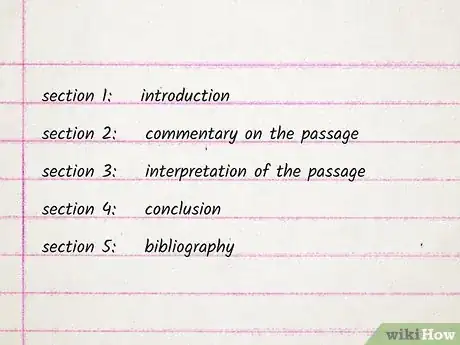
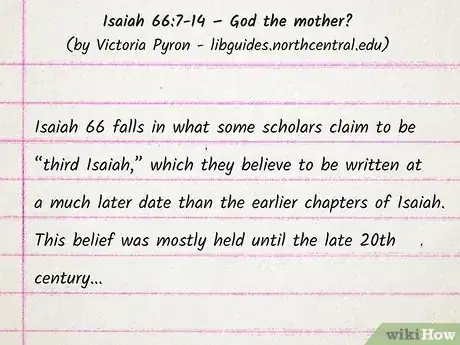
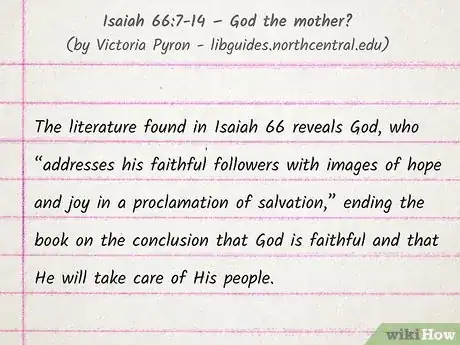
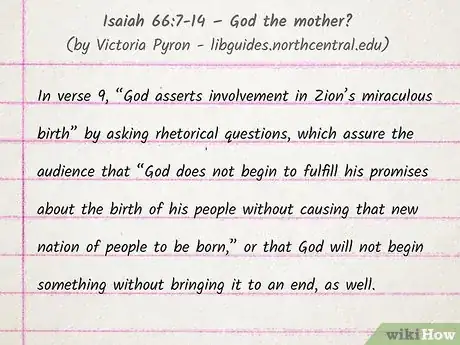

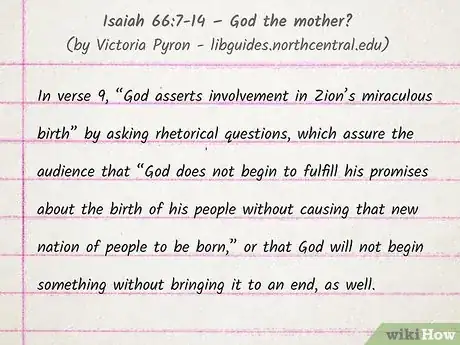
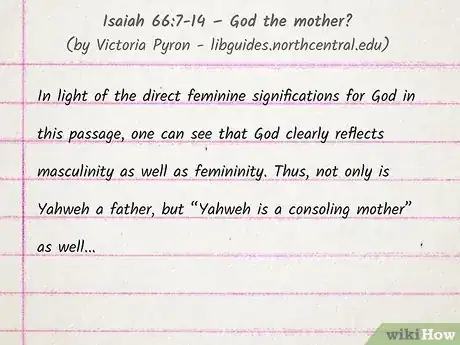
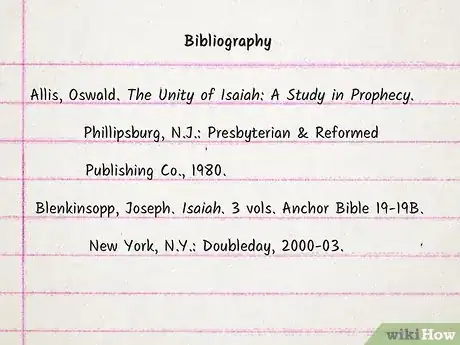





-Step-9.webp)






















-Step-9.webp)



































